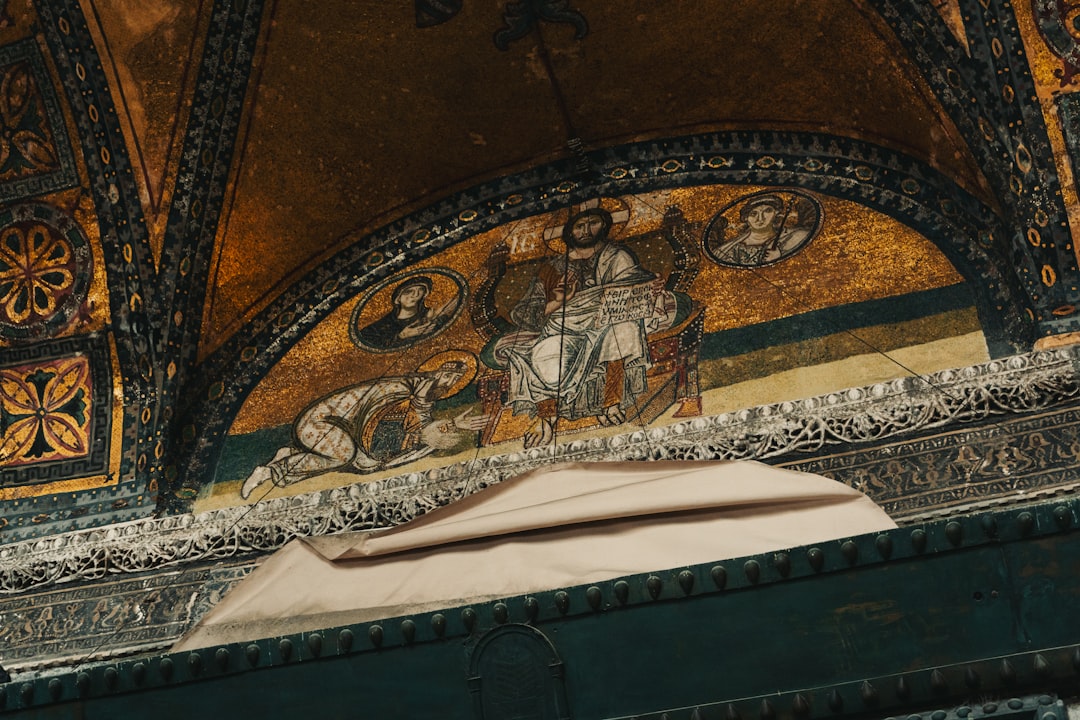
Istanbul, a city straddling two continents, is a melting pot of cultures. Its rich history is reflected in its diverse architecture. Among these architectural gems are the churches in Istanbul.
These churches are not just places of worship. They are historical landmarks, each with a unique story to tell. They bear witness to the city’s vibrant past, marked by the rise and fall of empires.
The Hagia Sophia, for instance, is a symbol of Istanbul’s religious evolution. It has served as a church, a mosque, and now a museum. Its grandeur and architectural brilliance continue to captivate visitors from around the world.
The Aya Irini Church, on the other hand, is a testament to Byzantine glory. It is one of the few churches that was not converted into a mosque, preserving its original Christian identity.
The Armenian Church in Istanbul reflects the city’s multicultural fabric. It stands as a symbol of the Armenian community’s resilience and enduring presence in the city.
The Aya Triada Church, a prominent Greek Orthodox church, showcases the influence of the Greek community. Its neo-baroque style is a sight to behold.
The churches in Istanbul are not just about religion. They are about history, culture, and art. They are about the people who built them, the communities they served, and the times they have weathered.
These churches have seen the city transform. They have witnessed periods of religious tolerance and conflict. They have survived earthquakes, fires, and wars.
Today, these churches continue to serve their communities. They are also open to visitors, offering a glimpse into Istanbul’s rich past. They are a testament to the city’s architectural prowess and cultural diversity.
This article will take you on a journey through these architectural wonders. It will delve into their history, their architectural styles, and their cultural significance.
Whether you are a tourist planning a visit, a history enthusiast, or a local interested in your city’s heritage, this guide is for you. Let’s explore the churches in Istanbul, these remarkable symbols of the city’s rich and diverse history.
Table of Contents
The Historical Tapestry of Istanbul’s Churches
Istanbul’s churches illustrate a historical tapestry woven over centuries. They reflect the city’s enduring links with Christianity, dating back to the Byzantine Empire. Churches like Hagia Sophia and Aya Irini originate from this era, embodying the grandeur of Byzantine architecture.
With each subsequent era, new layers were added to this tapestry. The conversion of many churches into mosques or museums during the Ottoman period reshaped their roles. Yet, they retained their architectural beauty and historical value.
Today, these churches in Istanbul stand as relics of the city’s layered past. Their architecture blends influences from various civilizations. They reveal stories of cultural exchange between the Romans, Byzantines, and Ottomans.

The Greek Orthodox Church in Istanbul is central to the city’s religious history. It underscores the Greek community’s historical and cultural contributions to Istanbul.
Armenian churches also play a vital part in this historical landscape. They highlight the presence and influence of the Armenian community over centuries.
These churches have weathered times of prosperity and hardship. Their resilience speaks to the enduring spirit of the communities they serve.
In the vibrant quarters of Istanbul, these churches add to the city’s unique architectural landscape. They are surrounded by narrow streets, bustling bazaars, and other historical structures.
This architectural variety is captivating. It attracts historians, architects, and tourists alike. It stands as a testament to Istanbul’s position as a crossroads of civilizations.
Thus, the churches in Istanbul offer more than just spiritual solace. They are historic anchors, connecting the past with the present. They enable us to experience the evolving story of a city at the heart of empires.
Hagia Sophia: A Monumental Transition
Hagia Sophia, a majestic emblem of Istanbul, boasts a fascinating history. Originally built as a church, it was dedicated in 537 AD under Emperor Justinian I. It was hailed as the world’s largest cathedral for nearly a thousand years.
Its architectural brilliance is unrivaled. A massive dome, supported by pendentives, highlights Byzantine architectural innovation. Its soaring height and sheer scale leave visitors awestruck.

In 1453, the Hagia Sophia underwent a transformative shift. The Ottomans converted it into a mosque, adding minarets and altering its interior. Yet, they preserved much of its original Christian art and architecture.
In 1935, it became a museum, symbolizing the secular vision of modern Turkey. Today, it serves both as a museum and a mosque, welcoming all who wish to witness its splendor.
This transition of Hagia Sophia from church to mosque to museum captures Istanbul’s dynamic history. It stands as a monument to the city’s religious and cultural evolution.
Aya Irini Church: A Testament to Byzantine Glory
Aya Irini Church, or Hagia Irene, stands opposite the Hagia Sophia. It offers a rare look into Istanbul’s Byzantine past, being one of the few churches not converted into a mosque. Its history is deeply intertwined with the early development of Christianity in the region.
Constructed in the 4th century, Aya Irini predates the Hagia Sophia. Its original form suffered damage in earthquakes and riots, but it was reconstructed under Emperor Justinian I, maintaining its importance.
The church’s interior is understated yet evocative. Original frescoes and mosaics have faded over time, but the sense of history is palpable. Aya Irini’s nave and atrium mirror the stately simplicity of early Christian architecture.

Today, Aya Irini serves a secular role. It hosts concerts and cultural events, leveraging its superb acoustics and historical ambiance. This adaptation allows modern audiences to appreciate its architectural grace and historical resonance.
Aya Irini remains a testament to the majestic yet understated glory of Byzantine architecture. It is a touchstone for visitors exploring Istanbul’s religious legacy.
The Armenian Churches: Preserving a Rich Heritage
Armenian churches in Istanbul highlight a significant cultural presence. Their history traces back to the Armenian Apostolic Church, maintaining vibrant traditions in a diverse city.
One notable example is the Holy Mother of God Armenian Patriarchal Church. This church serves as a focal point for Istanbul’s Armenian community. Its elegant architecture reflects both Armenian and Byzantine influences.
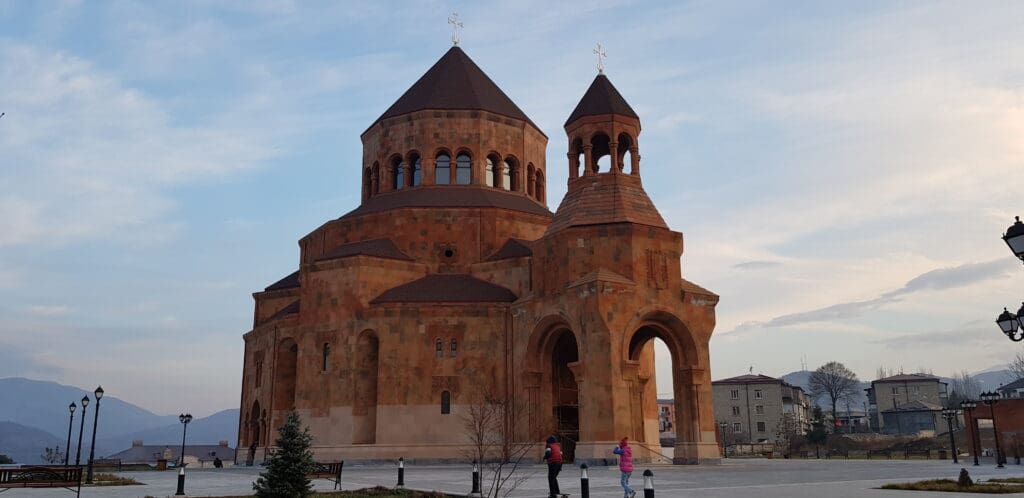
Armenian churches often feature distinctive architectural styles. They are marked by high domes and intricate stone carvings. These embellishments are not just ornamental. They reflect centuries-old traditions and religious motifs.
The churches are more than places of worship. They are community hubs, hosting gatherings and cultural events. They serve to strengthen community ties and preserve cultural heritage.
Despite historical challenges, Armenian churches continue to thrive. They embody resilience and respect for cultural continuity. These churches offer a rich cultural tapestry that adds depth to Istanbul’s architectural landscape.
Their presence enriches the city’s historical narrative. They stand testament to the enduring contributions of the Armenian community to Istanbul’s multifaceted identity.
Byzantine Brilliance and Ottoman Adaptations
Istanbul is a city where history whispers through every street. Its churches bear witness to eras of transformation. Byzantine and Ottoman influences converge, creating unique architectural stories.
The Byzantine Empire left a lasting imprint on Istanbul’s churches. Their architecture displayed grand domes and intricate mosaics. These elements embodied the spiritual and artistic peak of the era.
Ottoman adaptations added a new dimension. Many churches transformed into mosques, a testament to Istanbul’s dynamic history. This adaptation process often preserved and celebrated the Byzantine art beneath layers of Islamic design.
These churches offer a glimpse into the city’s dual identity. Ottoman minarets stand beside Byzantine domes in a harmonious dance. This blend attracts tourists and scholars alike, eager to explore these layers of history.

Istanbul’s sacred sites have continually evolved. Over time, they have served various religious communities, fostering interfaith dialogues. Their transformations tell stories of survival and adaptation in an ever-changing city.
Art and architecture from both periods survive side by side. They narrate a tale of cultural exchange and aesthetic merging. Byzantine frescos coexist with Ottoman calligraphy, enriching Istanbul’s cultural tapestry.
Preservation of these sites faces challenges. Yet, maintaining these buildings is key to safeguarding Istanbul’s diverse past. They are treasures that embody the city’s complex history.
Thus, Byzantine and Ottoman adaptations in Istanbul’s churches symbolize resilience and unity. They invite us to discover histories carved in stone, wood, and mosaic. They remind us that Istanbul is indeed a city of cultural confluence.
The Chora Church: A Mosaic Masterpiece
The Chora Church, known as Kariye Museum, is a jewel of Byzantine art. Its origins date to the 4th century. Yet, its breathtaking mosaics and frescos are marvels of the 14th century.
When you enter the Chora Church, you step into a storybook of faith. The mosaics vividly depict biblical scenes with exquisite detail. They offer a glimpse into the period’s artistic achievements.
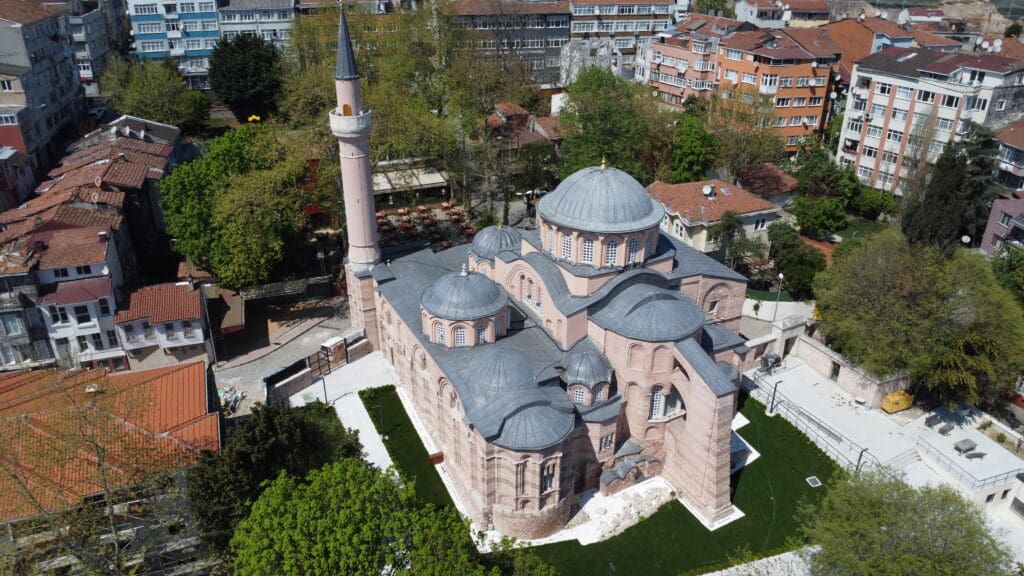
Ottoman influence altered the Chora Church’s function. It became a mosque in the 16th century. During its conversion, much of the Christian art remained hidden yet preserved.
Restoration uncovered its splendor, revealing vibrant golds and blues. These colors breathe life into biblical narratives that cover the walls. The church retains an intimate atmosphere, inviting contemplation and awe.
Visiting Chora Church is like entering a time capsule. It holds centuries of history in its intricate designs. This mosaic masterpiece continues to captivate and inspire, cementing its status as a must-visit landmark in Istanbul.
The Pammakaristos Church: A Mosaic of Histories
Pammakaristos Church, also known as the Fethiye Museum, is a vibrant amalgamation of histories. Its roots reach back to the 11th century when it served the Byzantine Empire.
This church is noted for its impressive mosaics, though not as extensive as Chora’s. They highlight the striking artistic prowess of the Byzantine era. The images display religious themes with expressive, emotive figures.
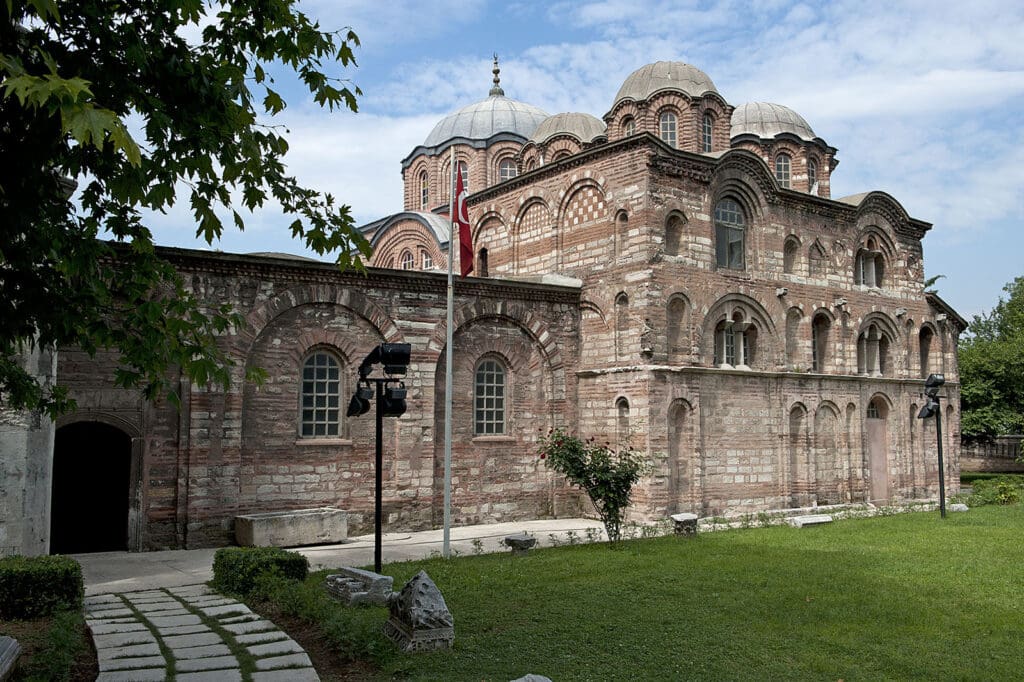
When Constantinople fell to the Ottomans, this church was also transformed. Converted into a mosque, it served the Islamic community while preserving Christian elements underneath.
In modern times, conservation efforts have unveiled some of its original artistry. Visitors today can admire its dynamic mosaics, though parts remain concealed. This artistic blend offers insight into a city in constant flux.
Pammakaristos embodies Istanbul’s essence. Its intricate mosaics and diverse history reveal a tapestry of cultural shifts. It serves as a symbol of resilience, resisting time and change yet preserving the beauty within its walls.
The Church of St. Mary of the Mongols: A Red Beacon
The Church of St. Mary of the Mongols stands out both in color and history. The only Byzantine church in Istanbul never converted into a mosque, it holds a unique position.
This church is nestled atop the historic neighborhood of Fener. Its striking red bricks make it a beacon among the winding streets. Its distinct architecture draws visitors intrigued by its past and present.
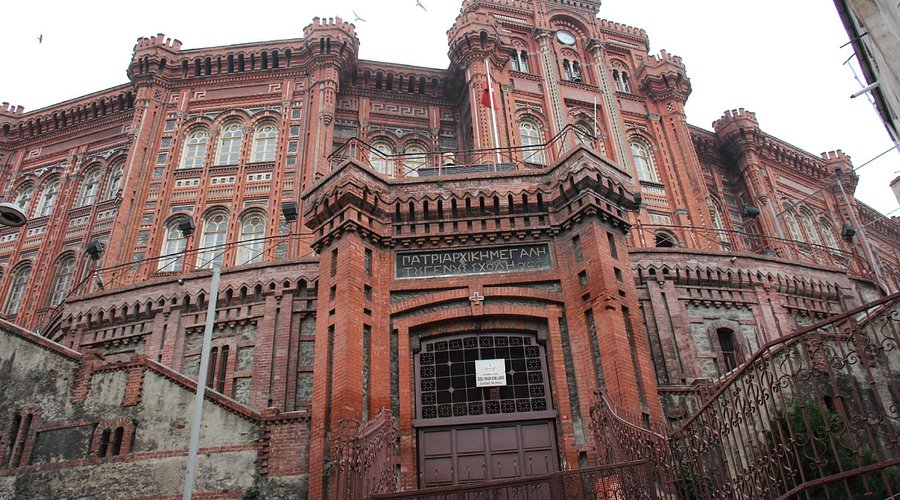
Founded in the late 13th century, its name honors Maria Palaiologina. She was a Byzantine princess married to the Mongol khan. Her influence led to the church’s dedication and enduring legacy.
Despite many historical challenges, the church remained a beacon of faith for the Greek Orthodox community. It was safeguarded by a special decree, allowing it to remain a Christian sanctuary.
Today, the Church of St. Mary of the Mongols serves a vibrant congregation. Its history reflects strength and spiritual devotion. It remains an inspiring testament to Istanbul’s richly woven cultural heritage.
The Greek Orthodox Legacy in Istanbul
The Greek Orthodox tradition holds a venerable place in Istanbul’s history. It marks centuries of spiritual and community life. This legacy continues to thrive amid the city’s vibrant diversity.
Greek Orthodox churches in Istanbul symbolize resilience. They serve as spiritual havens for the Greek community. These churches are not just places of worship but also guardians of cultural identity.
Each church reflects unique architectural styles, often blending Byzantine and newer elements. This fusion offers a visual narrative of the community’s journey through time. Their distinct designs attract historians and architects alike.
Pilgrimages to these churches are common among Greek Orthodox believers. They view the churches as spiritual anchors in a world of rapid change. This enduring faith binds the community both locally and globally.
Istanbul houses several key Greek Orthodox churches. Each holds stories of faith, perseverance, and artistic expression. These sites also stimulate interest in Byzantine studies, encouraging academic exploration.
The churches are centers for various community events. They host religious celebrations, which enrich Istanbul’s cultural calendar. These gatherings strengthen community ties and cultural knowledge among younger generations.
Active congregations breathe life into these historic buildings. They ensure the maintenance of liturgical traditions and ecclesiastical music. The churches, therefore, remain active participants in Istanbul’s spiritual landscape.
In essence, the Greek Orthodox presence in Istanbul is a living testimony. It showcases a blend of tradition and modernity. The churches represent bridges between past and present, offering insights into Istanbul’s multicultural identity.
Hagia Triada Greek Orthodox Church: Neo-Baroque Splendor
The Hagia Triada Greek Orthodox Church captivates visitors with its grandeur. Nestled in Istanbul’s bustling Beyoğlu district, it stands as a beacon of faith. The church, built in the late 19th century, embodies neo-baroque elegance.
Its impressive dome and detailed façade capture attention immediately. The exterior is richly adorned, reflecting the era’s artistic innovations. The fusion of Greek Orthodox tradition and baroque design showcases architectural brilliance.
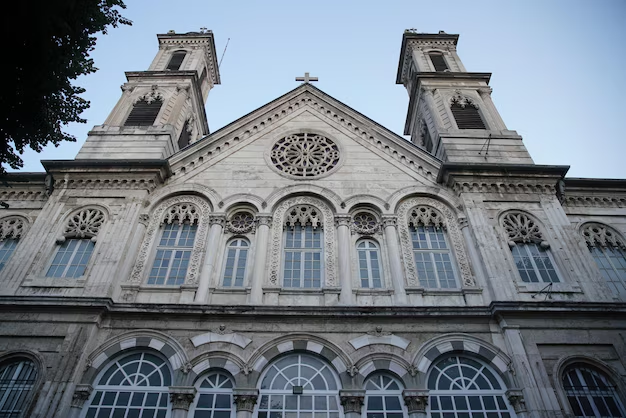
Inside, visitors are greeted by striking frescoes and mosaics. The church features tall stained-glass windows, which bathe the interior in colorful light. These elements blend seamlessly, enhancing the church’s spiritual ambiance.
Hagia Triada is more than just visually stunning. It is a vibrant center of worship for Istanbul’s Greek Orthodox community. Regular services and events draw the faithful, maintaining a sense of unity and tradition.
Despite many challenges, this church symbolizes endurance. It stands firm in its role, serving spiritual, cultural, and community needs. Hagia Triada continues to be a proud emblem of the Greek Orthodox heritage in Istanbul.
The Church of St. George: The Ecumenical Patriarchate
The Church of St. George holds profound significance in the Orthodox Christian world. Located in the Fener district, it serves as the seat of the Ecumenical Patriarchate. This establishment links it directly to the spiritual leadership of Orthodox Christianity.
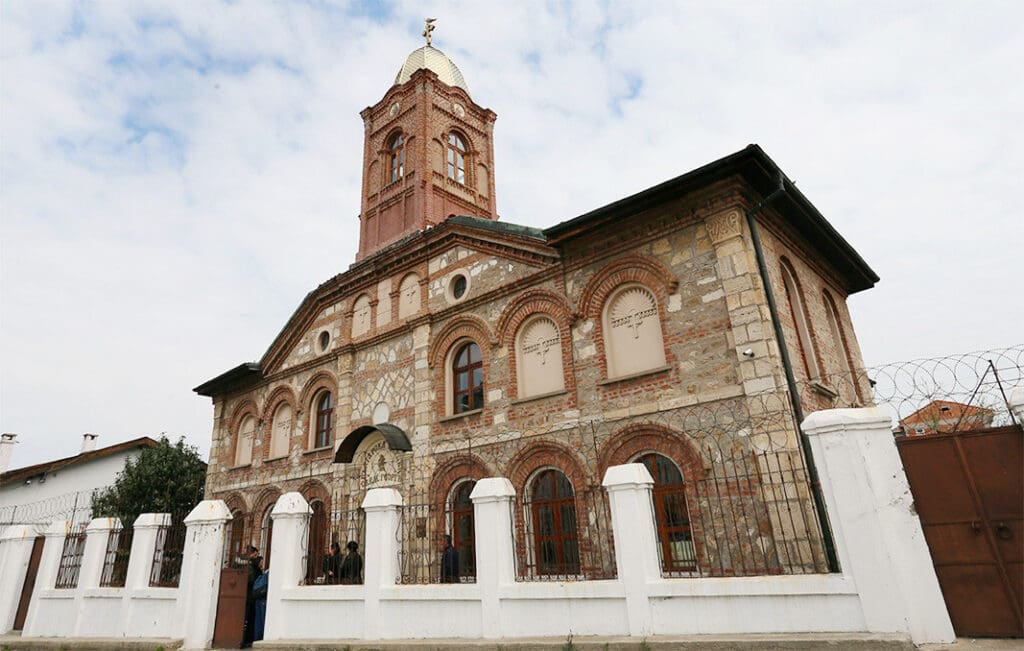
The building, dating back to the 19th century, carries rich symbolism. Although modest in size, its spiritual influence spans continents. The Ecumenical Patriarch is considered the “first among equals” in the Orthodox hierarchy.
The church’s interior holds priceless religious artifacts. Among them are icons, relics, and chalices of immense historical value. These relics are revered by pilgrims from across the world.
Despite geopolitical struggles, the Church of St. George remains a steadfast symbol of continuity. It bridges Orthodox communities globally, offering them spiritual and cultural guidance. It also stands as a monument to Istanbul’s diverse religious tapestry.
It remains an active center for dialogue, promoting peace and understanding. Conferences and ceremonies here address vital religious and cultural issues. Thus, the Church of St. George enhances Istanbul’s role as a crossroads of faith and culture.
Catholic and Protestant Presence
Istanbul, rich in cultural history, also hosts significant Catholic and Protestant sites. These churches add layers to the city’s multi-faith narrative. Their presence highlights Istanbul’s role as a melting pot of spiritual traditions.
Catholic churches, with their architectural distinctiveness, attract visitors worldwide. They often display Gothic influences, reflecting European heritage. Yet, they seamlessly integrate into Istanbul’s diverse skyline.
Protestant churches, though fewer, also play vital roles. They serve expatriate communities, offering solace and community spirit. These churches contribute to Istanbul’s dynamic religious landscape.
Both traditions have endured through centuries of change. They reflect resilience and adaptation, maintaining religious practices. This endurance enhances Istanbul’s rich tapestry of faith communities.
Consequently, these sites not only serve as worship centers. They also bridge cultural divides, promoting interfaith dialogue. Their ongoing presence signifies Istanbul’s inclusive spirit.
The Church of St. Anthony of Padua: A Catholic Landmark
The Church of St. Anthony of Padua, located on Istiklal Avenue, is Istanbul’s largest Catholic church. Established in the early 20th century, this architectural marvel draws visitors with its neo-Gothic design. The red brick façade, decorated with intricate details, stands out amidst the bustling cityscape.
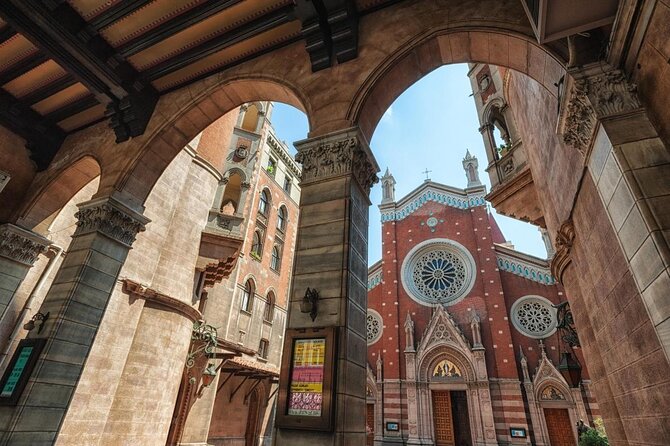
Inside, high ceilings and stained-glass windows create an aura of reverence. The church’s artful decorations include detailed altars and statues. The depiction of St. Anthony is a focal point, drawing both the faithful and art admirers.
A vibrant Catholic community animates this church with regular masses and religious ceremonies. The multicultural congregation includes locals and expatriates, uniting diverse backgrounds under one roof. This inclusivity strengthens communal ties, offering a spiritual haven.
The Church of St. Anthony is more than a place of worship. It hosts concerts and cultural events, enriching Istanbul’s arts scene. These activities engage broader audiences, fostering appreciation for Catholic traditions.
Historically, the church has witnessed Istanbul’s evolving landscape. It stands resilient through social and political changes. Today, it symbolizes spiritual endurance and celebrates Istanbul’s multicultural makeup.
The Crimean Memorial Church: Anglican Heritage
Nestled in the Taksim district, the Crimean Memorial Church is a testament to Istanbul’s Anglican heritage. Built in memory of those who perished in the Crimean War, the church dates back to 1858. Its Gothic Revival architecture offers a stark contrast to the surrounding modernity.
Constructed with characteristic pointed arches and detailed masonry, its façade commands attention. Inside, simple yet elegant pews and altars provide a serene setting. This understated design enhances the church’s contemplative atmosphere.
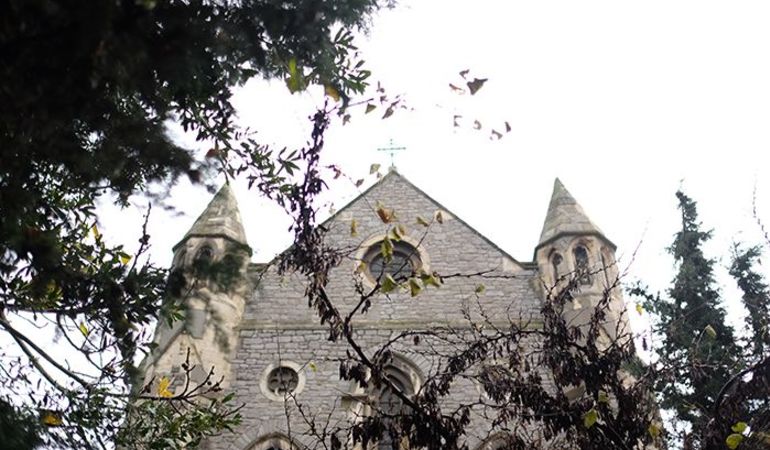
The congregation includes a mix of local residents and expatriate Anglicans. Regular services maintain its spiritual vibrancy, fostering a tight-knit community. The church serves as a cultural bridge, connecting Anglicans from various backgrounds.
Beyond worship, the church facilitates social activities. It hosts gatherings and charitable events, supporting local initiatives. These activities underline the church’s commitment to community welfare, echoing its historic social roles.
The Crimean Memorial Church, resilient through decades, remains pivotal. It not only preserves Anglican heritage but also enriches Istanbul’s religious diversity. As a symbol of faith and community service, it continues to inspire.
Preserving Istanbul’s Religious Architectural Heritage
Istanbul’s churches are treasures that anchor the city’s history and culture. Preserving them is both a necessity and a challenge. These structures require constant care to maintain their original glory.
Many churches face environmental wear and urbanization pressures. Efforts to preserve them are met with complex issues and resource constraints. Restoration projects often rely on public and private funding.
Dedicated organizations and local communities work tirelessly. They advocate for the preservation of these invaluable sites. Their combined efforts aim to safeguard cultural and religious legacies for future generations.
Conservation is about honoring the past while ensuring continued use. Many churches serve as active worship sites. Their preservation allows them to remain vibrant parts of the community.
Through these efforts, Istanbul’s churches continue to inspire. They stand as symbols of resilience, representing centuries of faith and cultural exchange. Their preservation ensures that Istanbul retains its character and charm.
Conservation Efforts and Challenges
Conserving Istanbul’s churches involves several challenges. These structures are often subject to weathering and urban development threats. High humidity and pollution further complicate preservation efforts.
Financial constraints often limit conservation projects. Securing adequate funding is crucial, yet difficult. Both local authorities and international organizations play vital roles in funding efforts.
Experts employ specialized techniques to restore delicate mosaics and frescoes. These skilled conservators must balance authenticity with modern methods. The work requires precision and dedication to historical accuracy.
Despite the hurdles, progress is evident in recent restoration achievements. Continued success depends on collaboration between government, private sectors, and communities. Addressing these challenges ensures these churches endure for generations.
Churches as Cultural and Tourist Attractions
Istanbul’s churches captivate tourists with their rich history and beauty. These architectural marvels are not just spiritual centers. They also serve as key cultural attractions in the city.
Tourists flock to admire their elaborate interiors and historic artifacts. The churches display a variety of architectural styles. From Byzantine mosaics to Gothic arches, the diversity is enthralling.
Visiting these sites offers an immersive historical experience. Tourists often gain insights into Istanbul’s multicultural past. This enhances understanding and appreciation of the city’s heritage.
Cultural programs and guided tours further elevate the tourist experience. These activities engage visitors, bringing history to life. Through tourism, the legacy of Istanbul’s churches continues to thrive.
Visiting Istanbul’s Churches: Tips and Insights
Exploring Istanbul’s churches offers a rich and rewarding experience. To make the most of your visit, a few tips will be helpful. Consider cultural norms, opening times, and religious practices.
Before you go, research each church’s visiting hours. Some churches have restricted access during certain religious services. Planning ensures you won’t miss seeing architectural highlights.
Try visiting during less busy times to avoid crowds. Early mornings or late afternoons often provide a more peaceful experience. These times also offer better light for photography.
Dressing modestly is respectful and sometimes required. Covering shoulders and knees is advisable in most churches. Bringing a scarf or shawl can be useful during your visit.
Engaging with local guides or tours can enrich your experience. They provide historical context that enhances your understanding. Knowledgeable guides can share intriguing stories about each site’s past.
Best Times to Visit and Worship Services
Timing your visit can greatly impact your experience. Weekday mornings are ideal for fewer crowds. You can explore at your own pace and reflect in peace.
If you’re interested in attending a service, check the schedule in advance. Most churches hold services on Sundays and special religious holidays. Attending a service offers a unique glimpse into local traditions.
Note that during services, some areas might be off-limits. Respect the space dedicated to worship when it is in use. Allow worshippers their privacy and partake in the experience quietly.
Visiting during festivals can be especially vibrant. These occasions often feature special decorations and events. Witnessing a service during these times offers a deeper cultural insight.
Respectful Tourism: Dos and Don’ts
Being a respectful tourist ensures everyone’s experience is positive. Always ask for permission before taking photos inside. Some areas may prohibit photography due to religious beliefs.
Keep your voice low, maintaining a calm demeanor. Churches are places of worship and introspection. Disruptions can disturb those in prayer and meditation.
Avoid eating or drinking inside these sacred spaces. Though snacks and water are travel essentials, save them for outside. Respecting these rules shows consideration for cultural norms.
Remember to remove your hat as a sign of respect. This small gesture is appreciated across all religious sites. By following these simple practices, you honor the sacredness of these spaces.
Conclusion
Istanbul’s churches are more than architectural feats; they are bridges to the past. Each church tells a unique story woven into the city’s vibrant tapestry. These sacred spaces offer insights into different cultures that have shaped Istanbul’s identity.
Visiting these churches unveils layers of history and tradition. Whether you are seeking spiritual solace or cultural enrichment, they provide both. Observing the harmonious blend of styles reveals the city’s diverse legacy.
As travelers, appreciating these wonders means honoring the preservation efforts. By doing so, we ensure future generations can marvel at Istanbul’s rich religious architecture. Through respect and understanding, we celebrate our shared human heritage.
FAQs
1. Are there churches in Istanbul?
Yes, Istanbul is home to many historic churches, including Orthodox, Catholic, and Protestant denominations.
2. What are the most famous churches in Istanbul?
Some of the most well-known include the Hagia Irene, Church of St. Anthony of Padua, and the Church of St. Stephen (Bulgarian Iron Church).
3. Can tourists visit churches in Istanbul?
Yes, most churches are open to visitors. Some may have limited visiting hours, especially during religious services.
4. Is there an entrance fee to visit the churches?
Most churches are free to enter, but some historic ones may charge a small fee or request donations.
5. What should I wear when visiting a church?
Modest attire is recommended. Avoid shorts, sleeveless tops, and revealing clothing out of respect.
6. Are church services held in English?
Some churches, especially Catholic and Protestant ones, offer services in English. It’s best to check their websites or call ahead.
7. Are the churches still active for worship?
Yes, many of the churches in Istanbul are still active and hold regular services for their communities.
8. Can I take photos inside the churches?
Photography rules vary by church. In many, photos without flash are allowed, but always check for signs or ask staff.
9. Are guided tours available?
Yes, guided tours that include churches are available through various travel agencies and local guides.
10. Where are most of the churches located in Istanbul?
Many churches are found in the Beyoğlu, Fatih, and Kadıköy districts, reflecting the city’s diverse Christian heritage.

